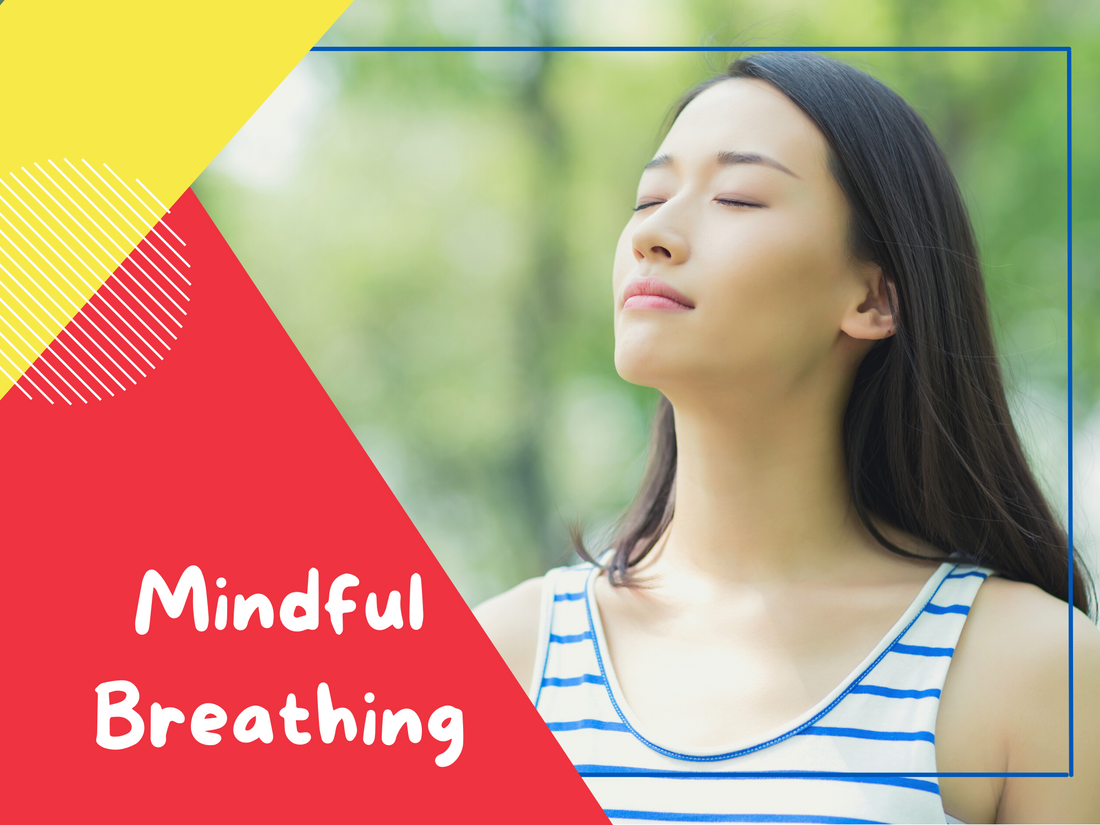Managing Stress with Breathing Exercises
Breathing exercises are a simple way to calm down and re-center yourself. Martial arts, yoga, and other activities incorporate breathing exercises. However, you don’t need to have a mat or be in the warrior one pose to benefit from breathing exercises.
You can do them anywhere, anytime, and in any position! They don’t take long. Even a few minutes of focusing on your breathing can help the rest of your day go smoother.
Understanding why breathing is so effective and how to breath properly might be the self-care you need to reduce stress and be more mindful.
Why is Breathing So Effective?
The mind can’t be happy if the body isn’t.
When we are in danger (or perceived danger caused by anxiety), our body cranks into the fight-or-flight gear. Studies have found that stress arouses our sympathetic nervous system, which you can think of as the general of our automatic responses to danger. The sympathetic nervous system boosts our heart rate, dumps mounds of glucose into our bloodstream, quickens our breathing, and many other things to prepare us for whatever it perceives as dangerous.
This is handy when there is a physical threat, but not when you’re stressed from teaching. Getting your mind to calm down begins with getting your body to relax.
You can’t control many of the physical symptoms associated with sympathetic arousal, but you can control your breathing. By taking deep, diaphragmatic breaths, you signal to your body that there is no real danger: you can relax. A study in 2002 on breathing-focused yoga found that deeper breathing was linked to reduced sympathetic activity, meaning reduced heart rate, blood pressure, etc.
General Tips on Mindful Breathing
To get the most out of 2-5 minutes of focused breathing, keep the following in mind:
1. Use diaphragmatic breathing, not thoracic breathing.
When you breathe, the air should fill your abdomen. Your chest should be moving very little. Short, fast breathing is associated with only breathing into the chest cavity. For the most calming effect, breaths should be deep and long.

If you are having a hard time telling how deep your breaths are, place your hand over your stomach.
2. Focus only on your breathing.
Try not to think about other things, and don’t be distracted by any other stimuli. Your attention should be completely focused on your breath. It may be helpful to close your eyes.
3. Get comfy.
You can be lying down, sitting, or standing up. Get comfortable but don’t fall asleep!
Breathing Techniques
There are a million different breathing techniques. Here are a few to get you started:
Equal Time Breathing
The equal time breathing technique focuses on breathing in for the same amount of time as you breathe out. If this is your first time practicing focused breathing, start with a short interval, such as 4 seconds, and work your way up to 10 seconds. This example will use 4 seconds, but you can change that time to fit your needs.
- Get comfortable.
- Breathe through your nose for 4 seconds.
- Exhale through your nose for 4 seconds.
- Repeat as many times as desired.
A derivative of equal time breathing is box breathing. The only difference is you hold your breath between inhaling and exhaling for 4 seconds. This is also called the four-square breathing technique or the 4-4-4 breathing technique.
Relaxing Breath
Also known as the 4-7-8 breathing technique, the relaxing breath is designed to put your body at ease. Once you are comfortable:
- Placing the tip of your tongue just behind your front teeth. Exhale all of the air in your lungs through your mouth.
- Shut your mouth and inhale through your nose for a count of 4.
- Hold your breath for 7 seconds.
- Gently exhale for a count of 8 through your mouth.
- Repeat
Muscle Relaxation Breathing

I recommend shutting your eyes for this breathing exercise. In this breathing technique, you take turns tensing and relaxing your muscles, one by one. Generally, this breathing exercise is done lying down, but you can do it sitting, too.
- Take a deep breath and tense your feet.
- Relax your feet as you breathe out.
- Take a deep breath and tense your calves.
- Relax as you breathe out.
- Continue to tense and relax all of the major muscle groups, including thighs, buttocks, diaphragm, hands, forearms, biceps, chest, neck, and face.
- Focus your mind on the tensed than relaxed muscle group as you do this exercise.
Mindful Breathing
This breathing technique focuses on bringing in good thoughts (peace, hope, calm) and letting go of negative ones (tension, anxiety, stress).
Choose a phrase or word that symbolizes both good and negative. Repeat the positive with each inhale and the bad with the exhale. For example, your inhale word might be “peace” and your exhale might be “release”.
Some people use the same word for both inhale and exhale. It doesn’t matter what you pick as long as you can focus on it, and it relaxes you.
Take a deep breath while thinking of your inhale phrase. Imagine positive energy (peace) is coming into your body through your lungs. Again, the breath should fill your diaphragm.
Think of your exhale phrase as you breathe out and imagine negative emotions and thoughts are leaving your body.
Repeat as many times as desired.
The Take Home
De-stressing doesn’t have to take long or be expensive. Breathing techniques are a great way to soothe the sympathetic nervous system and take a break from anxiety.
Teacher Power Cares
Teacher Power knows you have a full plate. That’s why we make tasty, energy-filled drinks – so you can do more than just make it through the day.

Keep reading our blog for more self-care topics, and check out our new products!
By: Emeline Haroldsen
The content of Teacher Power’s website is for information only, not advice or guarantee of outcome. Information is gathered and shared from reputable sources; however, Teacher Power is not responsible for errors or omissions in reporting or explanation. No individuals, including those taking Teacher Power products, should use the information, resources or tools contained within to self-diagnosis or self-treat any health-related condition. Teacher Power gives no assurance or warranty regarding the accuracy, timeliness or applicability of the content.
Sources:
Ma, Xiao et al. “The Effect of Diaphragmatic Breathing on Attention, Negative Affect and Stress in Healthy Adults.” NCBI. 2017. https://www.ncbi.nlm.nih.gov/pmc/articles/PMC5455070/
Vempati, R P, and Shirley Telles. “Yoga-based guided relaxation reduces sympathetic activity judged from baseline levels.” NIH. 2002. https://pubmed.ncbi.nlm.nih.gov/12061588/
Hoehn-Saric, R, and D R McLeod. “The peripheral sympathetic nervous system. Its role in normal and pathologic anxiety.” NIH. 1988. https://pubmed.ncbi.nlm.nih.gov/3047706/
Wang, Shu-Zhen et al. “Effect of slow abdominal breathing combined with biofeedback on blood pressure and heart rate variability in prehypertension.” NIH. 2010. https://pubmed.ncbi.nlm.nih.gov/20954960/
Richards, Jeffery C. & Bertram, Sandra. “Anxiety Sensitivity, State and Trait Anxiety, and Perception of Change in Sympathetic Nervous System Arousal” Journal of Anxiety Disorders. 2000. https://www.sciencedirect.com/science/article/pii/S0887618500000311
Jerath, R., Crawford, M.W., Barnes, V.A. et al. “Self-Regulation of Breathing as a Primary Treatment for Anxiety.” NIH. 2015. https://pubmed.ncbi.nlm.nih.gov/25869930/
Lanese, Nicoletta. “Fight or flight: The Sympathetic Nervous System”. Live Science. 2019. https://www.livescience.com/65446-sympathetic-nervous-system.html
Fowler, Paige. “Breathing Techniques for Stress Relief”. WebMD. 2020. https://www.webmd.com/balance/stress-management/stress-relief-breathing-techniques
Ankrom, Sheryl. “8 Deep Breathing Exercises to Reduce Anxiety”. Verywellmind. 2021. https://www.verywellmind.com/abdominal-breathing-2584115

